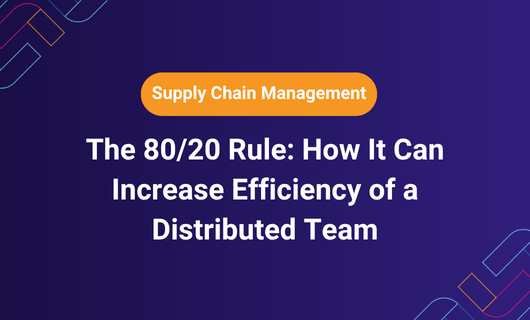Introduction
In today’s dynamic work environment, remote teams face unique challenges: communication barriers, time zone differences, and the constant battle against distractions. Amidst these challenges, the Pareto Principle, commonly known as the 80/20 Rule, emerges as a beacon for enhancing efficiency.
At Brankit Services, we harness the power of the 80/20 Rule to streamline operations, ensuring that our distributed teams focus on tasks that drive the most significant results. This article delves into the essence of the 80/20 Rule and its transformative impact on remote team productivity.

Understanding the 80/20 Rule
The Pareto Principle posits that 80% of outcomes result from 20% of causes. Originating from economist Vilfredo Pareto’s observation that 80% of Italy’s land was owned by 20% of its population, this principle has found relevance across various sectors, including business and time management.
In the context of remote work, this translates to:
- 20% of tasks contribute to 80% of productivity.
- 20% of clients generate 80% of revenue.
- 20% of communication issues cause 80% of misunderstandings.
By identifying and focusing on these critical areas, remote teams can optimize their efforts for maximum impact.
The Significance of the 80/20 Rule for Remote Teams
Addressing Common Remote Work Challenges
Remote teams often grapple with:
- Communication Overload: The reliance on digital tools can lead to excessive meetings and messages, diluting focus.
- Task Ambiguity: Without clear priorities, team members may spend time on low-impact activities.
- Isolation: Lack of face-to-face interactions can hinder collaboration and morale.
Implementing the 80/20 Rule helps in:
- Prioritizing High-Impact Tasks: Ensuring that the most critical activities receive the attention they deserve.
- Streamlining Communication: Focusing discussions on essential topics reduces noise and enhances clarity.
- Enhancing Morale: By achieving tangible results, team members feel more accomplished and connected.
Implementing the 80/20 Rule in Remote Teams
1. Task Prioritization
Begin by auditing current tasks to identify those that yield the highest returns. Tools like time-tracking software can provide insights into where time is spent versus where it should be allocated.
2. Effective Communication Strategies
- Asynchronous Communication: Encourage the use of tools that allow team members to communicate without the need for real-time responses, reducing interruptions and allowing for deeper focus.
- Structured Meetings: Limit meetings to essential discussions, with clear agendas and outcomes.
3. Delegation and Automation
Identify repetitive or low-impact tasks that can be delegated or automated. This frees up time for team members to concentrate on activities that drive significant results.
4. Regular Reviews
Periodically assess the effectiveness of implemented strategies. Adjust as necessary to ensure continuous alignment with the 80/20 principle.

Case Study: Enhancing Productivity with the 80/20 Rule
A mid-sized tech company faced challenges with its remote team’s productivity. By partnering with Brankit Services, they undertook the following steps:
- Task Audit: Identified that 25% of tasks were contributing to 75% of project milestones.
- Communication Overhaul: Reduced meetings by 40%, focusing only on high-priority discussions.
- Automation: Implemented tools to automate routine tasks, saving approximately 10 hours per week.
Results:
- Increased Efficiency: Project completion rates improved by 30%.
- Enhanced Morale: Team satisfaction scores rose by 20%.
- Cost Savings: Operational costs reduced by 15% due to optimized resource allocation.
Brankit Services: Your Partner in Remote Team Optimization
At Brankit Services, we specialize in transforming remote teams into high-performing units. Our approach includes:
- Customized Audits: Analyzing your team’s workflow to identify areas of improvement.
- Strategic Implementation: Developing tailored strategies aligned with the 80/20 Rule.
- Continuous Support: Providing ongoing assistance to ensure sustained efficiency.
Ready to elevate your remote team’s productivity? Contact Brankit Services today for a comprehensive consultation.
Frequently Asked Questions (FAQs)
Q1: What is the primary benefit of the 80/20 Rule for remote teams?
A: It helps in identifying and focusing on tasks that yield the most significant results, ensuring efficient use of time and resources.
Q2: How often should we review our task allocations?
A: Regular reviews, such as monthly or quarterly, are recommended to adapt to changing priorities and ensure continued alignment with the 80/20 principle.
Q3: Can the 80/20 Rule be applied to communication strategies?
A: Yes, by focusing on essential communications and reducing unnecessary interactions, teams can enhance clarity and reduce information overload.
Q4: How does Brankit Services assist in implementing the 80/20 Rule?
A: We provide tailored audits, strategic planning, and continuous support to help remote teams identify high-impact tasks and optimize workflows accordingly.
Conclusion
The 80/20 Rule offers a pragmatic approach to enhancing remote team efficiency. By focusing on tasks that drive the most significant outcomes, teams can achieve more with less effort. Brankit Services stands ready to guide your organization through this transformative journey, ensuring that your remote teams are not just operational but exceptional.
Take the first step towards optimized productivity. Schedule your consultation with Brankit Services now.





